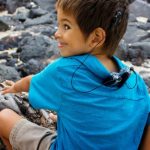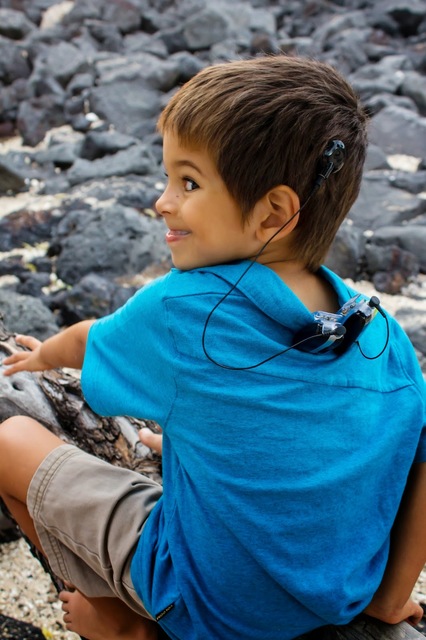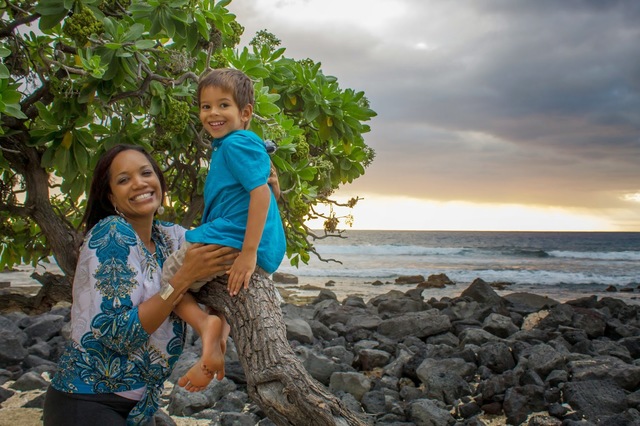Two years ago, Julian Beymer couldn’t communicate. He couldn’t speak his name, count, recite the alphabet or say “mommy.” He has a hearing loss and could have learned American Sign Language. But that’s not what his family wanted.
His family chose listening and spoken language. They want Julian to speak for himself, communicate with the world at large and have every opportunity to pursue the life he chooses.
Today, Julian is a happy 4-year-old preschooler with cochlear implants speaks like a 2-year-old. His mother, Grace Beymer, said he is doing well, despite inadequate educational services for children like him in Hawaii.
Grace realized Julian wasn’t hearing anyone when picking him up from daycare. His back faced her as she called him. He did not turn. His teacher got his attention by tapping his shoulder. He ran excitedly toward Grace. At home, Grace tested Julian’s hearing by banging pots near him. The noise was to no avail. At age 2, Julian was properly diagnosed with a hearing loss.
Once a child gets diagnosed with a hearing loss, the family chooses a communication mode and hearing aids or implants, if needed. In Hawaii, Grace said they are often offered ASL as the choice and then mainstreamed in public school programs, spending part of the day in the general education classroom and the remainder in special education.
Grace questions why Hawaii only offers programs that use ASL. She said most states honor three education choices for deaf and hearing-impaired students and have qualified professionals for each choice. Besides ASL, families can choose the total communication approach — a combination of sign language and visual oral speech — or an oral deaf education, which uses auditory verbal principles to teach listening and speaking. The latter is what Grace wants for Julian.
“Most hearing parents who have children with hearing loss choose to have their children utilize the technology of digital hearing aids or cochlear implants and oral deaf education so their children are not limited in who they can communicate with,” she said. “Research shows these children have better reading outcomes and better education outcomes across the board. If their hearing loss is caught early, proper amplification is worn, and proper intervention from oral deaf educators and auditory verbal therapists is received, these children are often mainstreamed and working at the same level as their peers by kindergarten or first grade. If they are caught a bit later, like my son, they can still catch up with their peers by middle school.”
Grace claims oral deaf education didn’t exist in Hawaii until she pushed Kealakehe Elementary School to start a program, which began this year. She said the school has its first-ever acoustic classroom and three children in the program, but the teacher working with them is not a teacher of the deaf, auditory verbal therapist or auditory verbal educator.
That “great” teacher, while “doing the best she can,” is not trained in the auditory/oral methodology of teaching students to listen and speak with amplification devices, Grace said. With today’s cochlear implants, kids can obtain normal range of speech. With cochlear implants, Julian hears 15 to 20 decibels and all speech zones. His hearing age is 1 year, 3 months.
Grace is grateful for the support Kealakehe’s administration and staff have provided, but it’s not enough. She said Julian and his classmates are not getting the education needed without a proper teacher. “Time is ticking for them to catch up to their peers in reading, speech, comprehension and development,” she added.
Grace said the Hawaii Department of Education couldn’t find an auditory verbal therapist or educator during recruitment. She contacted oral deaf education programs, encouraging people to apply. Some mainland candidates told her the salary DOE offered was too low — their main reason for declining the position.
DOE spokeswoman Donalyn Dela Cruz gave another perspective to what happened.
“The DOE was successful in generating interest in the position at Kealakehe and received applications from qualified applicants. However, the first candidate who was offered the position decided not to relocate and the second candidate, who was hired and worked at the school for a short period, then decided to return to the mainland for personal reasons,” she said. “A very capable teacher in substitute status currently fills the position.”
Dela Cruz stressed the DOE is continuing recruitment efforts at targeted institutions and working hard to fill the position.
“This is a specialized position that is sought after nationwide,” she said. “DOE has made every effort to try to fill the need for such positions, including recruiting at institutions on the mainland that have graduates in their specialized education field. We are competing for qualified educators with other school districts across the country.”
Meanwhile, Julian and his family have attended John Tracy Clinic, a leading diagnostic and education center for children with hearing loss, and its summer school in Sacramento, Calif. They’re also doing distance learning.
Despite challenges, Grace hasn’t given up on being an advocate for Julian or others like him. She continues to raise awareness, educate others and develop solutions. Her latest solution is House Bill 758, introduced by State Rep. Nicole Lowen, D-North Kona, which proposes prohibiting limits on the amount of professional experience credit DOE can grant to teachers hired for a shortage area.
“It creates bargaining ability, which is a must for a child like Julian who sits in his classroom without a proper teacher,” Grace said. “How many candidates will it take to say no to a position because of low pay before we realize we have to do something else and bargain? I believe our system can be changed.”
HB 758 provides additional incentives for educational specialists and other qualified teachers. At issue are the statutory pay scale restrictions that do not credit incoming teachers for their previous experience gained outside the state, according to the bill.
While DOE has no position on the bill, the Hawaii State Teachers Association does. Joan Lewis, HSTA vice president and lobbyist, said the union thinks it should be up to the Hawaii Teacher Standards Board to determine what’s appropriate and approved to attract the best quality teachers.
HB 758 appears to
be dead for this legislative session after missing a deadline to be heard.
However, Lowen is drafting a resolution and working on the best language to foster ways to accomplish the bill’s goals.
This was the second time Big Island lawmakers introduced legislation on Grace’s behalf. During the 2014 legislative session, HB 2228 attempted to require the state Department of Health to conduct a three-year pilot program on Hawaii Island to assist preschool-aged children with cochlear implants to acquire spoken language skills.
That bill was deferred indefinitely and a resolution drafted to form a working group addressing issues pertaining to assisting children with hearing impairment. The group’s progress was unknown, as of press time Thursday.
Email Carolyn Lucas-Zenk at clucas-zenk@westhawaiitoday.com.









